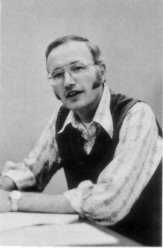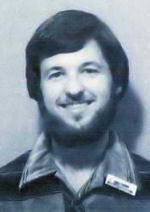|
HPIB: The Standard Interface
Growing the I/O team
|

|
|
Dick Barney
|
|
Dick Barney joined HP’s Loveland Instrument Division (LID) in Colorado in late 1969, after earning an MSEE from Montana State University. He was recruited by fellow alum Geoff Chance and Dick Moore, who was the LID R&D manager at the time. Barney joined Bob Watson’s calculator section of the LID R&D lab. This was after the HP 9100A had been introduced. By then, Barney recalls, the HP 9100A was “paying all of the bills.” Barney’s first big project at HP was the development of the HP 9866A thermal page printer, which he worked on until its release to production.
By the time the HP 9866A was released to the market, the Calculator Products Division (CPD) had split off from the Loveland Instrument Division and the second-generation desktop calculator/computers—the HP 9810A, 9820A, and 9830A had been introduced. The HP 9866A thermal page printer became a critical peripheral for the HP 9830A desktop computer because the computer had only a single-line LED display and the printer served in lieu of a multiline CRT display. it was especially important for debugging programs and for documenting program results.
Following the HP 9866A’s introduction, Barney joined the team developing the DC100 tape cartridge and drive that would be used in the next generation of HP’s desktop calculator/computers (the HP 9815A/S, 9825A/B/S/T, 9831A, 9835A/B, and the 9845A/B/C). However, Barney didn’t stay in the R&D lab. He soon joined CPD marketing to work on I/O-related marketing materials such as application notes. Eventually, when the HP 9825A project progressed sufficiently, it needed a marketing manager to work with the engineers in the R&D lab. Barney took the job.
So it was Dick Barney that was the marketing guy who went on an extended trip with Don Morris to do some serious market research that helped define the HP 9825A project. However, as the project continued to ramp up, it’s need for development engineers also grew and Dick Barney moved back to the lab. He joined Geoff Chance’s I/O section. Chance, who had recruited Barney from Montana State in 1969, also lived near Barney’s home in Loveland and they’d become friends.
Barney was tasked with developing hardware for the HP 98034A HPIB card (Project Rosemary). HPIB—the Hewlett-Packard Interface Bus—was poised to become a very important piece of HP technology. Its purpose was to unify all of the myriad interfaces used to connect instruments to calculators and computers by creating one standard that served all purposes.
HPIB was a much more advanced approach to solving the instrumentation I/O Tower-of-Babel problem addressed by the HP 2570A instrumentation coupler, developed by Geoff Chance and Bob Tinnen in the Loveland Instrument Division in the late 1960s. HPIB was developed in 1972 by HP’s Jerry Nelson and Dave Ricci, who guarded it jealously and had a hand in supervising all early implementations. That included the HP 9825A.
Early in the development of the HP 98034A HPIB card for the HP 9825A, Barney settled on the Nanoprocessor as the controller for his I/O card design. The Nanoprocessor was a very rudimentary microprocessor developed at LID using HP Loveland’s NMOS I manufacturing process technology. The Nanoprocessor was more of a state-machine controller than a microprocessor. Barney began to develop an I/O card around an embedded Nanoprocessor, but that meant that he also needed someone to write the code for the Nanoprocessor in the I/O card. That job fell to Ed Schlotzhauer, a LID R&D engineer.
|

|
|
Ed Schlotzhauer
|
|
Schlotzhauer had joined HP in 1973 after earning a BSEE from the University of Houston in 1971. He’d been “dabbling” in instrument design at LID, learning the ropes, but he was fascinated by software. So when the opportunity arose to develop code for the HPIB card, Schlotzhauer jumped on it. He got the job and he got an additional responsibility: Jerry Nelson wanted LID to have a significant amount of input on the way the I/O language additions were made to the HP 9825A’s HPL programming language and Schlotzhauer became Nelson’s conduit into that development. The person largely responsible for developing the I/O extensions to HPL was John Nairn.
Nairn suddenly had two big tasks. The first was to work with Mike Kolesar to develop the basic I/O protocols for communication between the HP 9825A desktop computer and its I/O cards. These protocols would have to support Kolesar’s HP 98032A parallel I/O card, the HP 98034A HPIB card, and all subsequent I/O cards as well. At the same time, Nairn had to work with Schlotzhauer to abstract the HPIB I/O primitives, which would be implemented with the home-grown HP Nanoprocessor.
When Schlotzhauer joined the project, he recalls, Barney’s hardware design was already fairly far along. However, it needed Nanoprocessor code to make the design operable. Nairn and Schlotzhauer agreed on the communication primitives that the HP 9825A and the HPIB I/O card would use to communicate and then Schlotzhauer painstakingly translated those commands into Nanoprocessor code.
The Nanoprocessor lacked a complete microprocessor ALU (arithmetic logic unit) but it did have shift, mask, bit-set, bit-clear, bit-test, jump, branch, and subroutine-call instructions. Schlotzhauer recalls using a rudimentary assembler running on an HP 2100-series minicomputer to program the Nanoprocessor. He more strongly recalls the need to carefully count the cycles used for each routine to get the timing correct. In those days, with the very slow clock rates in use, every machine cycle was precious. In addition, Schlotzhauer’s code was going into a ROM in the I/O card, so it had to be perfect. Fixing bugs in the code once the I/O card was released into the market would have been horrendously expensive for HP in terms of warranty costs and lost good will.
While Schlotzhauer was working on the development of the HPIB I/O card code, he was also reviewing Nairn’s work on the I/O ROMs for the HP 9825A and acting as LID’s representative on the project. Schlotzhauer remembers being very concerned about what HP’s customers would see and do when working with the I/O extensions to HPL. “There was a sense that this was something big.” he says.
Kolesar, Nairn, Barney, and Schlotzhauer collaborated to define the HP 9825A’s General I/O ROM. The option ROM’s purpose was to add the I/O capabilities that had evolved in the second-generation HP desktop calculators (the HP 9810, 9820, 9821, and 9830) to the HP 9825A. The General I/O ROM ultimately grew to include printer drivers, HP 9862A plotter drivers, and formatting commands. (Nairn’s days spent writing the auto dealership application package for Wang paid dividends in the General I/O ROM’s formatting commands.) However, the General I/O ROM alone did not make the HP 9825A into “a controller” as Chris Christopher had commanded. More was needed. A lot more.
The Extended I/O ROM took the HP 9825A into the world of instrument control. Nairn’s work with Dick Barney and Ed Schlotzhauer to develop a set of high-level HPIB commands added the language extensions needed to allow the HP 9825A to make HP instruments sing by making the full range of HPIB commands and responses available directly to the programmer through HPL, the HP 9825A’s high-level programming language. An “on interrupt” command and interrupt-driven I/O buffers allowed HP 9825A programmers to create interrupt-driven service routines in HPL. Binary operations allowed programmers to convert between decimal and octal number representations and to use Boolean operations to mask bits in status and control words. String conversion routines allowed automatic conversion from the modified ASCII character set used by the HP 9825A and other “foreign” character sets. Finally, a set of interface-control operations gave HPL programmers direct access to the status and control registers inside of the I/O cards for extremely deep I/O program control.
These features were unheard of in computing machines of this class. Nairn’s Extended I/O ROM did indeed transform the HP 9825A into a controller, per Chris Christopher’s wishes. The Extended I/O ROM combined with Dick Barney’s and Ed Schlotzhauer’s HP 98034A HPIB card made the HP 9825A into the world’s best instrument controller, per Jerry Nelson’s wishes.
After the HP 98034A HPIB card was released to production, Dick Barney became a project manager and moved to the HP 9845A development project under Chuck Near. Barney was in charge of the HP 9845A’s CRT design. Ed Schlotzhauer returned to LID and his next big project was the HP 3060A board tester.
Click here for the next part of the HP 9825 I/O story.
|
|
|
|
|
Dick Barney designed these two boards for the HP 9825A’s HPIB card, the HP 98034A. This card was the first I/O card to use HP Loveland’s Nanoprocessor (the large white integrated circuit in the lower photo). Ed Schlotzhauer wrote the code for the HP 98034A’s embedded Nanoprocessor. It was his first software project at HP.
The Nanoprocessor was nearly a microprocessor. It had a program sequencer and could perform logical operations but lacked arithmetic functions. Dick Barney used 40 integrated circuits (including two DIP switches that are the same size as integrated circuits) compared to the 30 integrated circuits that Mike Kolesar needed for the HP 98032A parallel I/O card. Note that one of the HP 98034A circuit boards is not square and that both boards are larger than those designed for the HP 98032A parallel I/O card. The larger size and irregular shape permit the addition of a third more integrated circuits than needed for the design of Mike Kolesar’s HP 98032A.
Also note the handwritten “-5.0V” on the Nanoprocessor (the big white chip). This specification is for the Nanoprocessor’s back-gate bias and it varied from one manufacturing batch to the next, so the correct voltage, measured during final testing, had to be printed on each chip. A resistor with a custom value was soldered into the board during the assembly of the HP 98034A to set this voltage properly.
|
|
Information on the I/O pages of this site came from interviews with: Don Morris, Geoff Chance, Chris Christopher, Mike Kolesar, John Nairn, Dick Barney, Larry Smith, Ed Schlotzhauer, and from the memories of Steve Leibson.
|
|
|
|